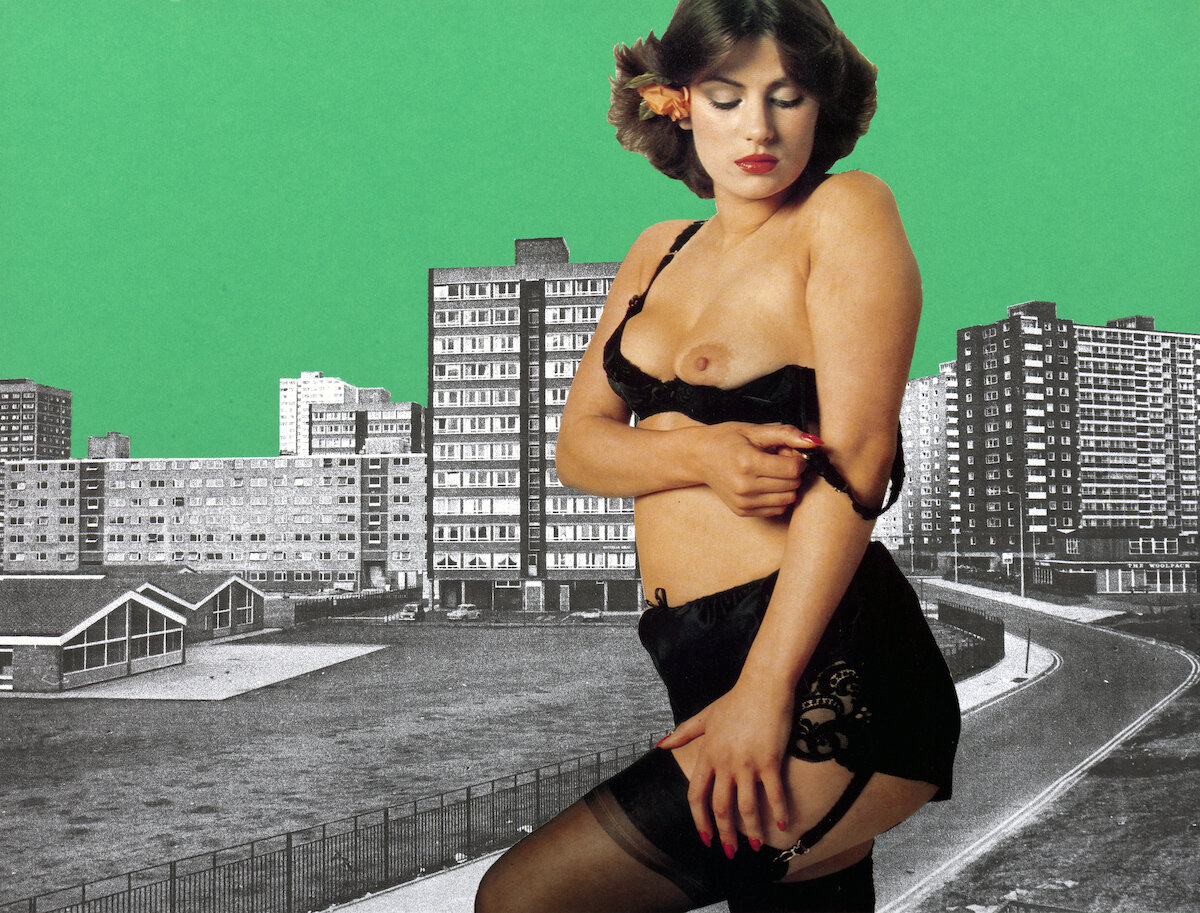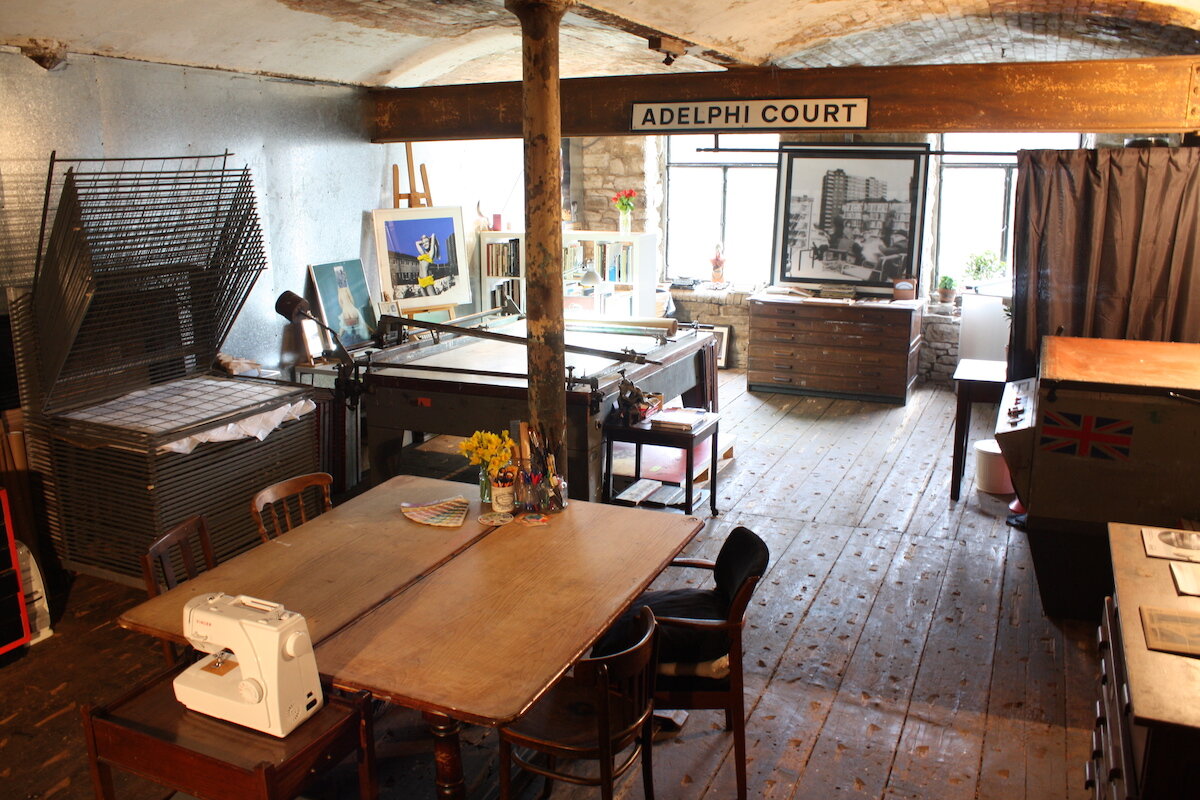Brutal / Beautiful: Sarah Hardacre in Conversation
Greg Thorpe
Almost All Dressed Up, 2012
In the first of a two part series, Greg Thorpe talks to artist Sarah Hardacre about brutalist tower blocks, shifts in pornography, and the politics behind her collage-based works. Their conversation occurs ahead of a joint exhibition of new work by Hardacre and fellow artist Sadé Mica that will be curated by Thorpe and presented at PAPER in 2021.
It’s been several years since artist Sarah Hardacre upped sticks from her beloved Salford and relocated 13 miles east to the town of Mossley in Greater Manchester’s Tame Valley. Out in her atmospheric studio in Woodland Mill, her visions of Salford still loom large. “There’s the sign I liberated from Adelphi Court,” she laughs, gesturing to a building name-panel that adorns one of the studio beams. Adelphi Court is the 1960s tower block on North George Street in Salford where Hardacre once lived, and one of many buildings lately deemed to be critically unsafe in the city’s post-Grenfell fire safety review. The spirit of Salford also thrives in the works that adorn the studio walls and work stations. These are Hardacre’s collages – ‘palimpsests’ is the term she favours – which feature dramatic images of concrete brutalist tower blocks photographed in their heyday when these bold futuristic residential structures first began to appear in our city landscapes, influenced by Le Corbusier’s high-rise visions of the future.
Hardacre’s studio at Woodland Mill
Many of the artist’s works consist of just two elements strategically combined: a background image (usually a photograph of a piece of brutalist architecture), overlaid with a picture of a naked or semi-clothed woman. Her images of women are lifted from vintage soft pornography. Hardacre is by necessity both an archivist and historian, immersed in trawling through imagery in public archives and vintage magazine emporiums alike. “I’ve really got into Penthouse magazine,” she enthuses, before also confessing: “sometimes I feel bad cutting up these old magazines, but then on the other hand I’m putting them in a new context and they will live forever.” The women are deliberately chosen because their bodies have not been artificially enhanced by surgery or silicone. In the original magazines their images sometimes appeared alongside high-brow contemporary writing from the likes of Lynn Barber or J.G. Ballard. “I always liked Ballard. His novel High Rise was a big influence on me. There’s an amazing Ballard article in Penthouse where he says: ‘science fiction is the only truth.’” It might be argued that High Rise more accurately predicted a type of future for tower-block living than Le Corbusier’s own utopian dreams.
As a fiction writer myself, Hardacre’s works in turn prompt me to imagine the lives of the women that feature in them, both the models and the unseen women who reside in the towers. The terrains of architecture and pornography might be man-made but are largely woman-inhabited. In the work of feminist collage artist Linder Sterling, women’s faces are replaced with consumer goods such as kettles, irons and food mixers; substitutions we can read through feminist politics around the commodification of women’s bodies, domesticity and ‘value’. Hardacre’s women are different. They are foregrounded, often huge, untouched and untouchable. Their faces are intact and often looking directly at us. Our gaze is returned in a powerful way as they tower above their surroundings. Hardacre also takes pleasure in their “different boobs, aureoles, massive bushes, little tummies and tan lines,” she tells me. She suggests that the explosion in pornography since the internet has stood in for an actual grown-up conversation about sex. “Porn has gotten harder and more accessible,” she says, “but we haven’t yet opened up about our sexuality.” Meanwhile the work itself is often censored online. “I’m always getting kicked off Facebook. My Instagram was deleted. My exhibition catalogue was taken down.”
Family, Private Property and the State, 2012
Hardacre’s practice is both motivated and informed by her working-class northern identity, and by the complex social, civic and political histories that make up that context. She is especially interested in what that changing context has meant for women. She is also fascinated by the ongoing possibilities of the north of England and the ideas that it has about itself, both its roots and its living heritage. She is a woman who makes her work in a mill, for example. She clog dances. She comes from a family of trade unionists who had something to say about justice and quality of life for working people, and her work has something to say about those things too. She is interested in intention and experience, in sexuality and structure. Her work brings to mind Corbusier’s assertion that ‘a house is a machine for living in.’ The artist gestures to one of her buildings: “These are the blocks where I lived.” The balconies structurally and metaphorically correspond with the vintage filing cabinets that she has collaged into the foreground. “You can imagine opening up the cabinets or the flats themselves and looking inside at the people’s lives,” she suggests.
*
“Cheer up! It’s all tomorrow’s chip paper!” one of the girls says to me. “I’m not bothered in the slightest, are you? Honestly, the pictures will be gone and forgotten soon enough. Then onto the next job. Just try and enjoy yourself, I do.” That sort of jimmied me on to go through with it. Then it was easy, a bit cold in the studio, met some very nice people, drank some tea, kept the knickers, which were lovely. It was all over dead quick. Before I knew it I was back out on the street, on my way to the train station with the money in my hand and the promise of another job coming. I slept a little bit funny that night I’ll admit. But the next day I looked at the notes in my purse and I soon got over it…
*
We’re under a mass of tarpaulin and scaffolding still, while they re-clad the place. It should’ve been fixed years ago. I’ve not seen sky from this walkway for months, only whatever light can get through the wrapping. It’s like being stuck inside an old snow-shaker. My plants are sick. The tower over the road from us has been sold and done up, every balcony in a different colour, new gardens, all the flats on sale to private owners. They’ve renamed it KONKREET, like that, with a ‘k’. The very top is the ‘Penthouse’. I asked Pete in our tower what life was like in a ‘penthouse’. ‘They charge me extra for the nosebleeds!’ he laughed. They even mailed the sales leaflets through our doors. Hundred and fifty grand to cross the road, I don’t think so…
*
The concrete has bled from the rain. The whole side of the tower is stained. Lots of families broke up. That second generation of sons became wayward. The communal areas were once the places where you’d gladly run into your neighbours. Now there are gangs of lads hanging around there and you have to sort of gather yourself up before you walk through. The walkways are strewn with porn mags. I used to know everyone who lived round here, but now I don’t. Some of these flats are meant to be empty but I still hear folk coming and going…
*
There was a little girl, with a little curl..., 2012
At university Hardacre worked with taxidermy and took advantage of the well-stocked workshops of her art school setting. After graduation, with more limited workspace, collage presented itself as a viable creative output, something that was “just so available to me at that time.” As her practice has developed, one of the rewarding depths of the work lies in the political and inescapably gendered correspondence between the images, and also in what the artist leaves in or leaves out – not just from the selected original but from the vast archives she encounters in the first place. The skill lies then in the fine handling of the source material itself. The artist’s work with a scalpel often makes the meeting of images imperceptible which in turn makes the finished pieces “both completely surreal but almost real,” as Hardacre describes, “somehow it looks like these things are meant to be there, even when it’s a giant woman.” In the past more than one of Hardacre’s curators have mistaken an original collage work for a digital reproduction, such is the pristine standard of her cutting and placement. “I take it as a compliment!” she says. Her original palimpsests might then also be reproduced for a screen print edition. Again, her technique is fastidious and satisfying, utilising 80gsm paper soaked in vegetable oil to make it translucent for exposure, with the screens themselves treated with a photosensitive solution, and each colour printed separately as a flat layer. The final results are vibrant, upscaled and striking works.
From 1 February to 21 March, Hardacre will exhibit a collection of works at The Modernist magazine’s headquarters on Port Street, central Manchester. Like Hardacre, The Modernist celebrates and reflects on 20th century architecture. “Architecture is often revered, whereas the porn magazines are seen as sleazy. In my work it’s the other way around,” she explains. The forthcoming show could make for a perfect setting for anyone to encounter her work for the first time. Later this year I will be writing more about this artist and we will then go on to curate an exhibition of her work together for PAPER Gallery as part of my role at the Fourdrinier. It will be good to welcome her back into a built-up city environment, to see the rapidly changing skyline and streets through her eyes, to imagine the stories within, and the work to come.
A joint exhibition of work by Hardacre and Sade Mica will show at PAPER in 2021. ‘Sarah Hardacre: Penthouse and Pavement’ is on display at The Modernist’s exhibition space at 58 Port Street in Manchester until 21 March.




